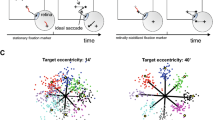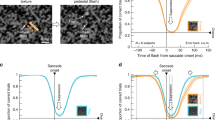Abstract
We investigated the accuracy of sequential saccadic eye movements, executed without visual feedback. We found evidence that the final error of one saccade is corrected during the next, which supports the existence of extraretinal inputs to the saccadic generator. The corrections, however, were incomplete, which suggests that extraretinal signals are only partially effective.
Similar content being viewed by others
References
Becker W (1991) Saccades. In: Carpenter RHS (eds) Eye movements. (Vision and visual dysfunction, vol 8) CRC, Boca Raton, Fla, pp 95–137
Becker W, Fuchs AF (1969) Further properties of the human saccadic system: eye movements and correction saccades with and without visual fixation points. Vision Res 9:1247–1258
Bock O, Arnold KE (1994) Error accumulation and error correction in sequential pointing movements. Exp Brain Res 95:111–117
Bock O, Eckmiller R (1986) Goal-directed arm movements without visual guidance: evidence for amplitude rather than position control. Exp Brain Res 62:451–458
Bock O, Kommerell G (1986) Visual localization after strabismus surgery is compatible with the “outflow” theory. Vision Res 26:1825–1829
Hallett PE, Lightstone AD (1976) Saccadic eye movements towards stimuli triggered by prior saccades. Vision Res 16:99–106
Li W, Matin L (1992) Visual direction is corrected by a hybrid extraretinal eye position signal. Ann NY Acad Sci 656:865–867
Ohtsuka K (1994) Properties of memory-guided saccades towards targets flashed during smooth pursuit in human subjects. Invest Ophthalmol Vis Sci 35:509–514
Ohtsuka K, Sawa M (1989) Accuracy of memory-guided saccades. Ophthalmologica 198:53–56
Sparks DL, Mays LE (1983) Spatial localization of saccade targets. I. Compensation for stimulation-induced perturbations in eye position. J Neurophysiol 49:45–63
Steinbach MJ (1987) Proprioceptice knowledge of eye position. Vision Res 27:1737–1744
Weber RB, Daroff RB (1972) Corrective movements following refixation saccades: type and control system analysis. Vision Res 12:467–475
Author information
Authors and Affiliations
Rights and permissions
About this article
Cite this article
Bock, O., Goltz, H., Bélanger, S. et al. On the role of extraretinal signals for saccade generation. Exp Brain Res 104, 349–350 (1995). https://doi.org/10.1007/BF00242020
Received:
Accepted:
Issue Date:
DOI: https://doi.org/10.1007/BF00242020




